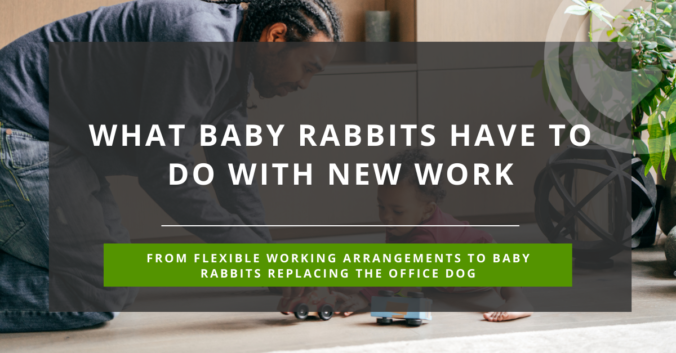When our founder Andreas Kitzing recently published a LinkedIn article about “Taking Parental Leave as a Startup CEO”, we all were positively surprised by the sheer volume of responses. Apparently, it’s still really unusual that people in leadership positions take parental leave, especially if they’re men.
We used this occasion to think about flexible work arrangements, which – to be frank – have been normal at Sponsoo since our foundation seven years ago. We strongly believe that our team members can perform best if they can work at a time, a place, and in a way that best fits with their individual preferences, with their biorhythm, and their family life. This is how we define “New Work”.
We should question gender roles in the workplace
According to a study from Mercer, at least 40% of the organizations around the globe are providing paid leave above the statutory minimum. Even the number of countries where paternity leave is enshrined in law has more than doubled to about 90 in the last 20 years. Yet, the number of men who take more than a few days off work when their child is born is very limited. Men are often still seen as the main breadwinner whilst women are responsible for childcare.
Struggling from expectations, as the “ideal worker”, men suffer from organizational pressures to embrace a professional identity that is devoted to their jobs. This is damaging for both sides: Middle-aged women are considered as “risks” who might become absent for longer periods of time due to maternal leave, and men are put under pressure to always put work before family.
We think that it is time to change this. At Sponsoo, everyone can take time off for the family. As mentioned before, this even includes top management: Our CEO Andreas Kitzing just returned from the first out of for months (part-time) paternity leave. “If my CEO can take paternity leave, I can take it as well” – we hope that this message has reached all the (future) parents in our organisation.
We also hope that we can encourage other employers to follow our example.

Saying farewell to “9 to 5”
Even prior to the outbreak of Corona, Sponsoo never had a rigorous 9 to 5 work schedule. It was a team based decision to implement the flexibility to start and finish whenever suits them best. We do however have a “core hours policy” starting from 10 to 16, where each member of the team has to be present or online during that time frame. This not only ensures that everyone can attend certain meetings when scheduled, but chats that would be tedious or time-consuming via email or slack can also be conducted during these hours.
However, in times where we do have to schedule or chat outside these core hours, our team wiki (confluence page) will come into play. It’s where all our preferred working schedules are listed, whether you are an early bird and prefer to start at 7, or a night owl, who doesn’t turn on his laptop till 10am. This ensures that everyone will roughly know each other’s schedule and helps them organise their team tasks.
Working from home is the new normal
While we slowly emerge from the pandemic, flexible working looks set to stay and is certainly no benefit that startups should miss out on. CCO Michael as an example chose a hybrid working arrangement, allowing him to combine onsite and offsite work as he sees fit with his parental schedule. “For someone who has to commute long distances, as well as being a father of three little boys, having flexible working hours was a vital aspect for me when choosing a new company to work for. I want to be able to freely make time for family related duties.”
However, having the freedom to choose working hours doesn’t just apply to parents. A 2018 Mercer study suggested that 51% of employees want their company to offer more flexible options. Adopting a flexible working culture is becoming a key trend not only for parents, but also for today’s digital generation. Many employees put this perk on top of their career benefits ladder. For them it’s obvious that they should be allowed to manage their own times as they like and to work when they are most productive.
The option to work flexibly and remotely is also extremely important for our Marketing Manager Sarah, even though she’s not a parent (yet) – at least not in the traditional sense. Being a member of the animal welfare association in Hamburg, she regularly cares for baby rabbits, squirrels or even bats that need rehabilitation before being freed into the wild. As she puts it: “I don’t want to choose between my work and caring for animals that are dependent on volunteers like myself.” By occasionally bringing her animals to work, she definitely replaces the office dog with her little baby bunnies and most certainly brings a smile to her office colleagues.

Structuring the New Age of Remote Work
When allowing employees to decide on their own schedules and work from locations that best suit their arrangements, the employees satisfaction increases significantly. However, setting some rules for structure may still be vital. Our rules for structure include implementing core hours (as mentioned above), telling each other when they are taking a break/finishing work for that day or making clear to each member of the team which type of communication channel they prefer.
Once these rules are implemented, the benefits are enormous. From less turnover, higher productivity, more diversity among staff and most importantly the ability to look for top talent without any restrictions.
“You are enabled to really attract the best talent to your organization. If a specific office location doesn’t limit you, you can look anywhere in the country or anywhere on the globe.” Nicole McCabe – Director of Global Diversity and Inclusion at SAP.
So be it from encouraging a family friendly environment, remote and flexible working schedules, it all adds up to a happier and more motivated team, which in turn leads to more remarkable outcomes that will benefit both the business and employees.

Leave a Reply